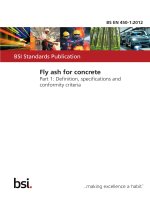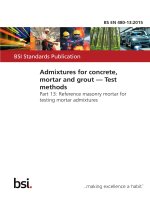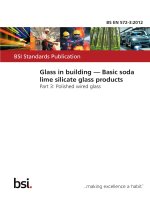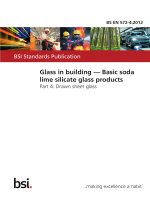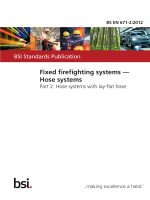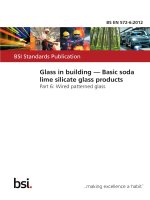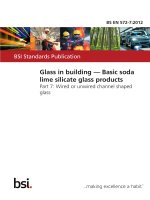Bsi bs en 62047 13 2012
Bạn đang xem bản rút gọn của tài liệu. Xem và tải ngay bản đầy đủ của tài liệu tại đây (1.23 MB, 18 trang )
BS EN 62047-13:2012
BSI Standards Publication
Semiconductor devices —
Micro-electromechanical
devices
Part 13: Bend- and shear- type test methods
of measuring adhesive strength for MEMS
structures
BRITISH STANDARD
BS EN 62047-13:2012
National foreword
This British Standard is the UK implementation of EN 62047-13:2012. It is
identical to IEC 62047-13:2012.
The UK participation in its preparation was entrusted to Technical Committee
EPL/47, Semiconductors.
A list of organizations represented on this committee can be obtained on
request to its secretary.
This publication does not purport to include all the necessary provisions of a
contract. Users are responsible for its correct application.
© The British Standards Institution 2012
Published by BSI Standards Limited 2012
ISBN 978 0 580 69450 9
ICS 31.080.99
Compliance with a British Standard cannot confer immunity from
legal obligations.
This British Standard was published under the authority of the Standards
Policy and Strategy Committee on 31 May 2012.
Amendments issued since publication
Amd. No.
Date
Text affected
BS EN 62047-13:2012
EUROPEAN STANDARD
EN 62047-13
NORME EUROPÉENNE
April 2012
EUROPÄISCHE NORM
ICS 31.080.99
English version
Semiconductor devices Micro-electromechanical devices Part 13: Bend- and shear- type test methods of measuring adhesive
strength for MEMS structures
(IEC 62047-13:2012)
Dispositifs à semiconducteurs Dispositifs microélectromécaniques Partie 13: Méthodes d'essais de types
courbure et cisaillement de mesure de la
résistance d'adhérence pour les structures
MEMS
(CEI 62047-13:2012)
Halbleiterbauelemente Bauelemente der Mikrosystemtechnik Teil 13: Biege- und Scherprüfverfahren
zur Messung der Haftfestigkeit bei MEMSStrukturen
(IEC 62047-13:2012)
This European Standard was approved by CENELEC on 2012-04-03. CENELEC members are bound to comply
with the CEN/CENELEC Internal Regulations which stipulate the conditions for giving this European Standard
the status of a national standard without any alteration.
Up-to-date lists and bibliographical references concerning such national standards may be obtained on
application to the CEN-CENELEC Management Centre or to any CENELEC member.
This European Standard exists in three official versions (English, French, German). A version in any other
language made by translation under the responsibility of a CENELEC member into its own language and notified
to the CEN-CENELEC Management Centre has the same status as the official versions.
CENELEC members are the national electrotechnical committees of Austria, Belgium, Bulgaria, Croatia, Cyprus,
the Czech Republic, Denmark, Estonia, Finland, France, Germany, Greece, Hungary, Iceland, Ireland, Italy,
Latvia, Lithuania, Luxembourg, Malta, the Netherlands, Norway, Poland, Portugal, Romania, Slovakia, Slovenia,
Spain, Sweden, Switzerland, Turkey and the United Kingdom.
CENELEC
European Committee for Electrotechnical Standardization
Comité Européen de Normalisation Electrotechnique
Europäisches Komitee für Elektrotechnische Normung
Management Centre: Avenue Marnix 17, B - 1000 Brussels
© 2012 CENELEC -
All rights of exploitation in any form and by any means reserved worldwide for CENELEC members.
Ref. No. EN 62047-13:2012 E
BS EN 62047-13:2012
EN 62047-13:2012
-2-
Foreword
The text of document 47F/109/FDIS, future edition 1 of IEC 62047-13, prepared by SC 47F, "Microelectromechanical systems", of IEC TC 47, "Semiconductor devices" was submitted to the IEC-CENELEC
parallel vote and approved by CENELEC as EN 62047-13:2012.
The following dates are fixed:
•
•
latest date by which the document has
to be implemented at national level by
publication of an identical national
standard or by endorsement
latest date by which the national
standards conflicting with the
document have to be withdrawn
(dop)
2013-01-03
(dow)
2015-04-03
Attention is drawn to the possibility that some of the elements of this document may be the subject of
patent rights. CENELEC [and/or CEN] shall not be held responsible for identifying any or all such patent
rights.
Endorsement notice
The text of the International Standard IEC 62047-13:2012 was approved by CENELEC as a European
Standard without any modification.
-3-
BS EN 62047-13:2012
EN 62047-13:2012
Annex ZA
(normative)
Normative references to international publications
with their corresponding European publications
The following documents, in whole or in part, are normatively referenced in this document and are
indispensable for its application. For dated references, only the edition cited applies. For undated
references, the latest edition of the referenced document (including any amendments) applies.
NOTE When an international publication has been modified by common modifications, indicated by (mod), the relevant EN/HD
applies.
Publication
Year
Title
EN/HD
Year
IEC 62047-2
2006
Semiconductor devices - Microelectromechanical devices Part 2: Tensile testing methods of thin film
materials
EN 62047-2
2006
–2–
BS EN 62047-13:2012
62047-13 IEC:2012
CONTENTS
1
Scope ............................................................................................................................... 5
2
Normative references ....................................................................................................... 5
3
Terms and definitions ....................................................................................................... 5
4
Test method ..................................................................................................................... 6
5
4.1 General ................................................................................................................... 6
4.2 Data analysis .......................................................................................................... 7
Test equipment ................................................................................................................. 8
6
5.1
5.2
5.3
5.4
5.5
Test
7
6.1 Design of test pieces ............................................................................................... 9
6.2 Preparation of test pieces ........................................................................................ 9
Test conditions ................................................................................................................. 9
8
7.1
7.2
7.3
7.4
Test
General ................................................................................................................... 8
Actuator .................................................................................................................. 8
Force measurement sensor ..................................................................................... 8
Alignment system .................................................................................................... 8
Recorder ................................................................................................................. 8
pieces ....................................................................................................................... 9
Method for gripping ................................................................................................. 9
Speed of testing ...................................................................................................... 9
Alignment of test piece ............................................................................................ 9
Test environment................................................................................................... 10
report...................................................................................................................... 10
Annex A (informative) Technical background ....................................................................... 11
Bibliography .......................................................................................................................... 14
Figure 1 – Columnar test pieces ............................................................................................. 6
Figure 2 – Adhesive strength test method ............................................................................... 7
Figure 3 – Alignment between columnar test piece and loading tool ...................................... 10
Figure A.1 – Example of the RRT results (see [1]) ................................................................ 11
Figure A.2 – Effects of aspect ratio of columnar test piece on the stress condition in
bend type test (see [2]) ......................................................................................................... 12
Figure A.3 – Effects of knife edge angle of loading tool and aspect ratio of columnar
test piece on the stress condition in bend test ....................................................................... 13
BS EN 62047-13:2012
62047-13 IEC:2012
–5–
SEMICONDUCTOR DEVICES –
MICRO-ELECTROMECHANICAL DEVICES –
Part 13: Bend - and shear - type test methods
of measuring adhesive strength for MEMS structures
1
Scope
This part of IEC 62047 specifies the adhesive testing method between micro-sized elements
and a substrate using the columnar shape of the specimens. This international standard can
be applied to adhesive strength measurement of microstructures, prepared on a substrate,
with width and thickness of 1 µm to 1 mm, respectively.
Micro-sized elements of MEMS devices are made up of laminated fine pattern films on a
substrate, which are fabricated by deposition, plating, and/or coating with photolithography.
MEMS devices include a large number of interfaces between dissimilar materials, at which
delamination occasionally occurs during fabrication or in operation. Combination of the
materials at the junction determines the adhesive strength; moreover, defects and residual
stress in the vicinity of the interface, which are changing by processing condition, strongly
affect the adhesive strength. This standard specifies the adhesive testing method for microsized-elements in order to optimally select materials and processing conditions for MEMS
devices.
This standard does not particularly restrict test piece material, test piece size and
performance of the measuring device, since the materials and size of MEMS device
components range widely and testing machine for micro-sized materials has not been
generalized.
2
Normative references
The following documents, in whole or in part, are normatively referenced in this document and
are indispensable for its application. For dated references, only the edition cited applies. For
undated references, the latest edition of the referenced document (including any
amendments) applies.
IEC 62047-2:2006, Semiconductor devices – Micro-electromechanical devices – Part 2:
Tensile testing method of thin film materials
3
Terms and definitions
For the purposes of this document, the following terms and definitions apply.
3.1
adhesive bend strength
nominal strength at failure on adhesive joint area by bending mode
3.2
adhesive shear strength
nominal strength at failure on adhesive joint area by shear mode
BS EN 62047-13:2012
62047-13 IEC:2012
–6–
33
1
1
44
SS
3
D
4
lc
2 2
TT
IEC 192/12
Key
Configurations or specimen
Dimensions of specimen
1
Top view
D
diameter of columnar test piece
2
Side view
lc
length of columnar test piece
3
Column type test piece
l c /D
aspect ratio of columnar test piece
4
Substrate
Τ
thickness of substrate
S
spacing between columnar test pieces
Figure 1 – Columnar test pieces
4
4.1
Test method
General
This standard specifies the adhesive testing methods between a columnar test piece (see
Figure 1) and substrate. Displacement or force is applied to a columnar test piece at a
constant speed and the force at delamination is measured to analyze the adhesive strength
between the columnar test piece and substrate. A knife edge shape with tapered tip is utilized
as the loading tool to apply the force to a columnar test piece. The angle of the knife edge is
changed by loading types of measuring adhesive strength as follows.
In case of measuring adhesive bend strength by applying bending force at the end of a
columnar test piece (bend type test), the knife edge of loading tool is used by slanting its apex
in the upper direction against the test piece as shown in Figure 2 a). In such a case, it is
easier to align the loading tool and a test piece since point load is applied at the end of the
columnar test piece. Attention should be drawn to the fact that the bend type test is not pure
bending, which includes compression component to the columnar root. The compression
component increases by increasing the contact angle of the knife edge. In order to minimize
the effect of compression component, the contact angle of the knife edge ( θ b ) should be
within a range of from 10° to 20°.
BS EN 62047-13:2012
62047-13 IEC:2012
–7–
In case of measuring adhesive shear strength by applying shear force on the lateral face of a
columnar test piece (shear type test), line load is applied to the test piece using a loading tool
which is parallel to the lateral face of the cylinder as shown in Figure 2 b). In such a case, the
test apparatus should have a precise alignment system, which can align the knife edge
parallel to the lateral face of the cylinder. Or alternatively, the knife edge of loading tool is
used by slanting its apex in lower direction against the test piece as shown in Figure 2 b) to
minimize the effects of bend stress (see Clause A.2).The angle error ( θ s ) should be within a
range of from 0° to 15°. It should be noted that the test results from the bend type test are
affected by the aspect ratio (l c /D), when the aspect ratio is less than 1,2. See Clause A.2. In
addition, the columnar test piece with the aspect ratio of less than 0,5 should not be applied in
the bend type test; because the effects of the aspect ratio on the shear and the compression
stress on the adhesive joint area significantly increase when the aspect ratio decreases. See
Clause A.2 and Clause A.3.
FF
F
F
lltt
33
lt
3
Rc
θbb
R
Rc
θθss
11
22
11
22
lp
lp
lp
lp
IEC 193/12
Figure 2a – Bend type test
IEC 194/12
Figure 2b – Shear type test
NOTE This figure illustrates two types of the test method for measuring adhesive strength between a columnar
test piece and substrate.
Key
Configurations or specimen
Supply and dimensions of specimen
1
Columnar test piece
F
loading force supplied by a kind of actuator
2
Substrate
lp
distance between the loading position and substrate
3
Knife edge of loading tool
lt
distance between the tip of the loading tool and
substrate
θb
angle between the lateral face of a columnar test piece
and contact face of knife edge for bend type test
θs
angle between the lateral face of a columnar test piece
and contact face of knife edge for shear type test
Figure 2 – Adhesive strength test method
4.2
Data analysis
In adhesive strength test by bend loading, adhesive bend strength is calculated by the
following Equation (1).
σa =
where
M a 32 Fmax l p 32 Fmax lc
=
=
Z
pD 3
pD 3
(1)
–8–
σa
is the adhesive bend strength;
Z
is the section modulus of a columnar test piece;
Ma
is the bend moment at delamination;
F max
is the maximum load at delamination;
lp
is the loading point from the root of a columnar test piece.
BS EN 62047-13:2012
62047-13 IEC:2012
In adhesive strength test by shear loading, adhesive shear strength is calculated by the
following Equation (2).
τa =
Fmax 4 Fmax
=
A
πD 2
(2)
where
τa
is the adhesive bend strength;
A
is the adhesive joint area between a columnar test piece and substrate;
F max
is the maximum load at delamination.
In the bend type test, it is required to be attentive to the possibility of exfoliation due to shear
force if the aspect ratio (l c /D) of the columnar test piece is less than 1,2. See 4.1 and Clause
A.2.
5
5.1
Test equipment
General
The test equipment shall be capable of applying microscopic displacement or micro-level
force to the test piece. The test equipment consists of an actuator for applying displacement,
a sensor for force measurement, a controller applying displacement or force at a constant
speed, an alignment system between the test piece and the loading tool, and a recorder for
detecting the load at delamination.
5.2
Actuator
Displacement or force should be linearly applied along the loading axis of the test piece at a
constant speed. Thus, the actuator shall be capable of linearly applying displacement or force
at a constant speed.
5.3
Force measurement sensor
Load cell with enough resolution, which guarantees 5 % accuracy of the measured adhesive
strength shall be used for the force measurement. The force sensor shall be set to measure
the force to the loading direction. The knife edge of the loading tool shall be located within the
effective measuring area of the force sensor. See Figure 3.
5.4
Alignment system
The alignment system shall be capable of aligning the test piece and loading tool in the
proper position to apply displacement or force in the correct direction (see 7.3).
5.5
Recorder
The test equipment shall include a recorder for detecting the force at delamination.
BS EN 62047-13:2012
62047-13 IEC:2012
6
6.1
–9–
Test pieces
Design of test pieces
The test piece should satisfy the following two items:
a) It is recommended that the dimensions of a test piece, such as the columnar diameter and
length,, are in the same order as the size of parts of a device to be evaluated;
b) Every gap between the test pieces (S) should provide more than twice compared with both
the diameter of columnar test piece (D) and the length of test piece (l c ) to prevent each
piece from having an influence on the test of adjacent test piece (see Figure 1). In
addition, the gap (S) should be sufficiently larger than the width of the knife edge tip of the
loading tool (l k ) to avoid loading two columnar test pieces at the same time. See Figures 1
and 3.
6.2
Preparation of test pieces
A number of columnar test pieces with the same manufacturing process and conditions are
obtained, since a plurality of columnar test pieces are prepared on the same substrate.
The test pieces should satisfy the following two items:
a) Test pieces should be prepared on a substrate through an almost identical manufacturing
process and under the same manufacturing conditions as those applied when fabricating
the thin film of the device to be evaluated;
b) More than ten columnar test pieces should be prepared on the same substrate at the
same time. Then, adhesive testing should be performed using more than ten columnar
test pieces under the same testing conditions (see Clause A.1).
7
7.1
Test conditions
Method for gripping
Substrate of test pieces shall be fixed according to the following two items:
a) Substrate of test pieces shall be fixed at test device ensuring not to move during adhesive
strength test. Clauses A.2 and A.3 of IEC 62047-2:2006 shall apply;
b) Substrate of test pieces shall be fixed such as the loading direction of the test device is
parallel with the substrate surface. See 7.3.
7.2
Speed of testing
Displacement speed or loading speed should be constant. As the speed of testing will depend
upon the testing environment, the type of testing machine employed and the stiffness of the
test piece, the speed shall be the one which is more suitable for the particular combination of
environment, material, test piece, and testing machine. Generally, the speed of testing should
be chosen properly depending on the application of the materials.
7.3
Alignment of test piece
The alignment of the test piece shall satisfy the following item:
a) The surface of the test piece substrate shall be parallel to the axis of loading direction
within 3° accuracy. See Figure 3 a) ;
In addition, the alignment of loading equipment and substrate should satisfy the following
three items:
b) Contact surface of the loading knife edge shall be normal to the plane including loading
axis and normal of a test piece substrate. See Figure 3 b);
BS EN 62047-13:2012
62047-13 IEC:2012
– 10 –
c) In the case of the bend type test, the distance between the loading tool and the substrate,
l t should be larger than 10 % of the columnar length (l c ) to avoid contact between each
other. See Figure 2 a);
d) In the case of the shear type test, the tip of loading tool should be kept at a distance (l t )
from the substrate to avoid contact between each other. l t should be within a range of
10 % of the columnar diameter (D), provided that D is 10 µm and larger. l t should be
within 1 µm, provided that D is less than10 µm. See Figure 2 b).
4
A
A
llkk
5
5
6
6
55
33
33
77
11
11
22
22
A’
A’
8
8
IEC 195/12
Figure 3a – Side view of columnar test
piece and loading tool
IEC 196/12
Figure 3b – Cross-section of A-A’
Key
Configurations or specimen
Direction or plane for alignment
1
Columnar test piece
5
Loading axis (loading direction)
2
Test piece substrate
6
Surface of test piece substrate
3
Loading tool
7
Contact surface of the loading knife edge
4
Load cell
8
Plane including loading axis and normal of a
test piece substrate
lk
width of the knife edge tip
Figure 3 – Alignment between columnar test piece and loading tool
7.4
Test environment
As the environment greatly affects the adhesive properties of micro-materials, the test
temperature and humidity should be controlled within ± 1 °C and ± 5 %, respectively.
8
Test report
Test reports shall include at least the following:
a) reference to this standard, i.e. IEC 62047-13;
b) materials of the columnar test piece and substrate;
c) dimensions of the columnar test piece and substrate as well as spacing between adjacent
columnar test piece;
d) preparation method of test piece and the details;
e) test conditions such as test device and test loading condition;
f)
test environment such as temperature and humidity;
g) measurement results and calculated adhesive strength.
BS EN 62047-13:2012
62047-13 IEC:2012
– 11 –
Annex A
(informative)
Technical background
A.1
Outline of round-robin tests performed in Germany and Japan
Validities of adhesive strength test methods between a micro-sized columnar test piece and a
substrate described in Clause 4, as well as the testing method presented in this standard are
verified as results of round-robin tests (RRT) described as follows.
Round-robin tests (RRT) were performed from 2008 to 2009 in Germany and Japan. The RRT
were carried out with the participation of several universities in Germany and Japan.
The materials used in the RRT were epoxy type photoresist, SU-8 and silicon wafer. Several
different dimensions of SU-8 columnar test pieces were prepared for the RRT. A number of
the micro-sized columnar test pieces with each dimension were fabricated on each wafer
under the same manufacturing condition. The RRT were carried out using each particular
material testing machine for micro-sized materials in each institute, which can apply precise
displacement and/or force with constant rate. Adhesive tests were carried out under
displacement control mode and both force and displacement were measured during the tests.
The adhesive strengths were compared within each of the different-sized columnar test pieces.
On the basis of finding from the RRT, this standard was developed.
Figure A.1 shows an example of the testing results obtained from the RRT in each institute.
Specimen A
diameter of 125 µm
aspect ratio of 0,8
Specimen B
diameter of 125 µm
aspect ratio of 1,2
Maximum tensile stress at delamination/MPa
150
100
θb
Univ. 1: 45°
Univ. 2: 45°
Univ. 3: 10°
50
0
Univ. 1
Univ. 2
Univ. 3
Univ. 1 Univ. 2
Univ. 3
IEC 197/12
NOTE 1 This graph shows one of the RRT results, which is obtained from bend type tests using two differentsized SU-8 columns on Si substrate. 10 to 20 test pieces of each different-sized column were tested in each
institute, because adhesive strength data tend to be scattered.
NOTE 2 In columnar test pieces with an aspect ratio of 1,2 (specimen B), the maximum tensile stress at
delamination (the adhesive bend strength) is about the same in each laboratory.
NOTE 3 In columnar test pieces with an aspect ratio of 0,8 (specimen A), the adhesive bend strength is about the
same as that in specimen B, when the knife edge angle of the loading tool ( θ b ) is 10°. On the other hand, the
adhesive bend strength is larger than that in specimen B, when θ b is 45°.
Figure A.1 – Example of the RRT results (see [1] 1)
___________
1
Figures in square brackets refer to the bibliography.
BS EN 62047-13:2012
62047-13 IEC:2012
– 12 –
A.2
Effects of the aspect ratio of columnar test piece on the adhesive bend
strength in bend type test
This standard utilizes columnar shape as the adhesive test piece for evaluation of adhesive
strength between micro-sized components and a substrate in MEMS. A reason to adopt the
shape is that point loading at the end of the column is possible in the adhesive tests under
bend loading condition. Therefore, proper loading can be applied to the end of the columnar
specimen under the point loading mode without the strict adjustment for alignment.
However, consideration shall be given to the effects of the aspect ratio of the columnar
specimens on adhesive strength obtained from the adhesive testing under the bend loading
condition. Figure A.2 shows that the proportion of the shear stress to the maximum tensile
stress increases when decreasing the aspect ratio.
In case of a columnar test piece with an aspect ratio of less than 0,5, there is high possibility
that the delamination occurs by the shear stress because the proportion of the shear stress
becomes larger, as shown in Figure A.2. Hence, the columnar test piece with the aspect ratio
shall adopt shear loading type.
In the case of a columnar test with an aspect ratio of 0,5 to 1,2, the effective stress for
delamination is transferred from the shear stress to the maximum tensile stress when
increasing the aspect ratio as shown in Figure A.2. That is to say, it is not clear which causes
the delamination: the shear stress, the maximum tensile stress or mixture of them. Therefore,
it is recommended that the bend type test does not applied to the columnar test piece within
the aspect ratio of 0,5 to1,2.
Shear stress/maximum
tensile stress
Shear
stress / Max. tensile
stress
0,5
0,5
0,4
0,4
0,3
0,3
0,2
0,2
0,1
0,1
00
0
0
0,5
0,5
1,0
1
1,5
1,5
2,0
2
2,5
2,5
Aspect
(columnarlength
length/diameter)
Aspect
ratioratio
(columnar
/ diameter)
3,0
3
IEC 198/12
Figure A.2 – Effects of aspect ratio of columnar test piece on the stress condition
in bend type test (see [2])
A.3
Effects of knife edge angle of loading tool on the adhesive bend strength
in bend type test
In the case of the bend type test, the proportion of compression stress at the adhesive joint
area to maximum tensile stress at the columnar root increases when increasing the knife edge
angle of loading tool ( θ b ). The effects cannot be neglected at the larger angle of θ b as shown
in Figure A.3. Hence, θ b should be within the range of 10° to 20°in the bend type test.
Compression stress/maximum tensile stress
Compression stress / Max. tensile stress
BS EN 62047-13:2012
62047-13 IEC:2012
– 13 –
0,5
0,5
45°
30°
20°
0,4
0,3
0,2
10°
0,1
00
00
0,5
0,5
1,0
1
1,5
1,5
2,0
2
45°
30°
20°
10°
Aspect
ration
(columnarlength
length/diameter)
Aspect
ratio
(Columnar
/ diameter )
IEC 199/12
NOTE Each line in this graph shows the calculated result using each different knife edge angle of loading tool to
the lateral face of columnar test piece.
Figure A.3 – Effects of knife edge angle of loading tool and aspect ratio
of columnar test piece on the stress condition in bend test
– 14 –
BS EN 62047-13:2012
62047-13 IEC:2012
Bibliography
[1]
Toshikazu Tasaki, Tso-Fu Mark Chang, Chiemi Ishiyama, Masato Sone, Study on
delamination mechanism of SU-8 micropillars on a Si-substrate under bend loading by
Weibull analysis Microelectronic Engineering 88 (2011) 2132–2134
[2]
Chiemi Ishiyama, Akinobu Shibata, Masato Sone, and Yakichi Higo Effects of Aspect
Ratio of Photoresist Patterns on Adhesive Strength between Microsized SU-8 Columns
and Silicon Substrate under Bend Loading Condition Japanese Journal of Applied
Physics 49 (2010) 06GN14
___________
This page deliberately left blank
NO COPYING WITHOUT BSI PERMISSION EXCEPT AS PERMITTED BY COPYRIGHT LAW
British Standards Institution (BSI)
BSI is the national body responsible for preparing British Standards and other
standards-related publications, information and services.
BSI is incorporated by Royal Charter. British Standards and other standardization
products are published by BSI Standards Limited.
About us
Revisions
We bring together business, industry, government, consumers, innovators
and others to shape their combined experience and expertise into standards
-based solutions.
Our British Standards and other publications are updated by amendment or revision.
The knowledge embodied in our standards has been carefully assembled in
a dependable format and refined through our open consultation process.
Organizations of all sizes and across all sectors choose standards to help
them achieve their goals.
Information on standards
We can provide you with the knowledge that your organization needs
to succeed. Find out more about British Standards by visiting our website at
bsigroup.com/standards or contacting our Customer Services team or
Knowledge Centre.
Buying standards
You can buy and download PDF versions of BSI publications, including British
and adopted European and international standards, through our website at
bsigroup.com/shop, where hard copies can also be purchased.
If you need international and foreign standards from other Standards Development
Organizations, hard copies can be ordered from our Customer Services team.
Subscriptions
Our range of subscription services are designed to make using standards
easier for you. For further information on our subscription products go to
bsigroup.com/subscriptions.
With British Standards Online (BSOL) you’ll have instant access to over 55,000
British and adopted European and international standards from your desktop.
It’s available 24/7 and is refreshed daily so you’ll always be up to date.
You can keep in touch with standards developments and receive substantial
discounts on the purchase price of standards, both in single copy and subscription
format, by becoming a BSI Subscribing Member.
PLUS is an updating service exclusive to BSI Subscribing Members. You will
automatically receive the latest hard copy of your standards when they’re
revised or replaced.
To find out more about becoming a BSI Subscribing Member and the benefits
of membership, please visit bsigroup.com/shop.
With a Multi-User Network Licence (MUNL) you are able to host standards
publications on your intranet. Licences can cover as few or as many users as you
wish. With updates supplied as soon as they’re available, you can be sure your
documentation is current. For further information, email
BSI Group Headquarters
389 Chiswick High Road London W4 4AL UK
We continually improve the quality of our products and services to benefit your
business. If you find an inaccuracy or ambiguity within a British Standard or other
BSI publication please inform the Knowledge Centre.
Copyright
All the data, software and documentation set out in all British Standards and
other BSI publications are the property of and copyrighted by BSI, or some person
or entity that owns copyright in the information used (such as the international
standardization bodies) and has formally licensed such information to BSI for
commercial publication and use. Except as permitted under the Copyright, Designs
and Patents Act 1988 no extract may be reproduced, stored in a retrieval system
or transmitted in any form or by any means – electronic, photocopying, recording
or otherwise – without prior written permission from BSI. Details and advice can
be obtained from the Copyright & Licensing Department.
Useful Contacts:
Customer Services
Tel: +44 845 086 9001
Email (orders):
Email (enquiries):
Subscriptions
Tel: +44 845 086 9001
Email:
Knowledge Centre
Tel: +44 20 8996 7004
Email:
Copyright & Licensing
Tel: +44 20 8996 7070
Email:
